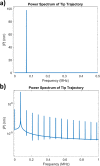Current measurements in the intermittent-contact mode of atomic force microscopy using the Fourier method: a feasibility analysis
- PMID: 32215233
- PMCID: PMC7082697
- DOI: 10.3762/bjnano.11.37
Current measurements in the intermittent-contact mode of atomic force microscopy using the Fourier method: a feasibility analysis
Abstract
Atomic force microscopy (AFM) is an important tool for measuring a variety of nanoscale surface properties, such as topography, viscoelasticity, electrical potential and conductivity. Some of these properties are measured using contact methods (static contact or intermittent contact), while others are measured using noncontact methods. Some properties can be measured using different approaches. Conductivity, in particular, is mapped using the contact-mode method. However, this modality can be destructive to delicate samples, since it involves continuously dragging the cantilever tip on the surface during the raster scan, while a constant tip-sample force is applied. In this paper we discuss a possible approach to develop an intermittent-contact conductive AFM mode based on Fourier analysis, whereby the measured current response consists of higher harmonics of the cantilever oscillation frequency. Such an approach may enable the characterization of soft samples with less damage than contact-mode imaging. To explore its feasibility, we derive the analytical form of the tip-sample current that would be obtained for attractive (noncontact) and repulsive (intermittent-contact) dynamic AFM characterization, and compare it with results obtained from numerical simulations. Although significant instrumentation challenges are anticipated, the modelling results are promising and suggest that Fourier-based higher-harmonics current measurement may enable the development of a reliable intermittent-contact conductive AFM method.
Keywords: Fourier analysis; atomic force microscopy (AFM); conductivity; current; intermittent contact; tapping-mode AFM.
Copyright © 2020, Uluutku and Solares; licensee Beilstein-Institut.
Figures



 is the contact time.
is the contact time.





Similar articles
-
Size Measurement of Nanoparticles Using Atomic Force Microscopy: Version 1.1.2009 Oct. In: National Cancer Institute’s Nanotechnology Characterization Laboratory Assay Cascade Protocols [Internet]. Bethesda (MD): National Cancer Institute (US); 2005 May 1–. NIST - NCL Joint Assay Protocol, PCC-6. 2009 Oct. In: National Cancer Institute’s Nanotechnology Characterization Laboratory Assay Cascade Protocols [Internet]. Bethesda (MD): National Cancer Institute (US); 2005 May 1–. NIST - NCL Joint Assay Protocol, PCC-6. PMID: 39013048 Free Books & Documents. Review.
-
Tapping mode imaging and measurements with an inverted atomic force microscope.Langmuir. 2006 Jul 18;22(15):6701-6. doi: 10.1021/la060002i. Langmuir. 2006. PMID: 16831016
-
Topography imaging with a heated atomic force microscope cantilever in tapping mode.Rev Sci Instrum. 2007 Apr;78(4):043709. doi: 10.1063/1.2721422. Rev Sci Instrum. 2007. PMID: 17477672
-
Material property analytical relations for the case of an AFM probe tapping a viscoelastic surface containing multiple characteristic times.Beilstein J Nanotechnol. 2017 Oct 26;8:2230-2244. doi: 10.3762/bjnano.8.223. eCollection 2017. Beilstein J Nanotechnol. 2017. PMID: 29114450 Free PMC article.
-
Lab on a tip: Applications of functional atomic force microscopy for the study of electrical properties in biology.Acta Biomater. 2019 Nov;99:33-52. doi: 10.1016/j.actbio.2019.08.023. Epub 2019 Aug 16. Acta Biomater. 2019. PMID: 31425893 Review.
References
Grants and funding
LinkOut - more resources
Full Text Sources
Miscellaneous
